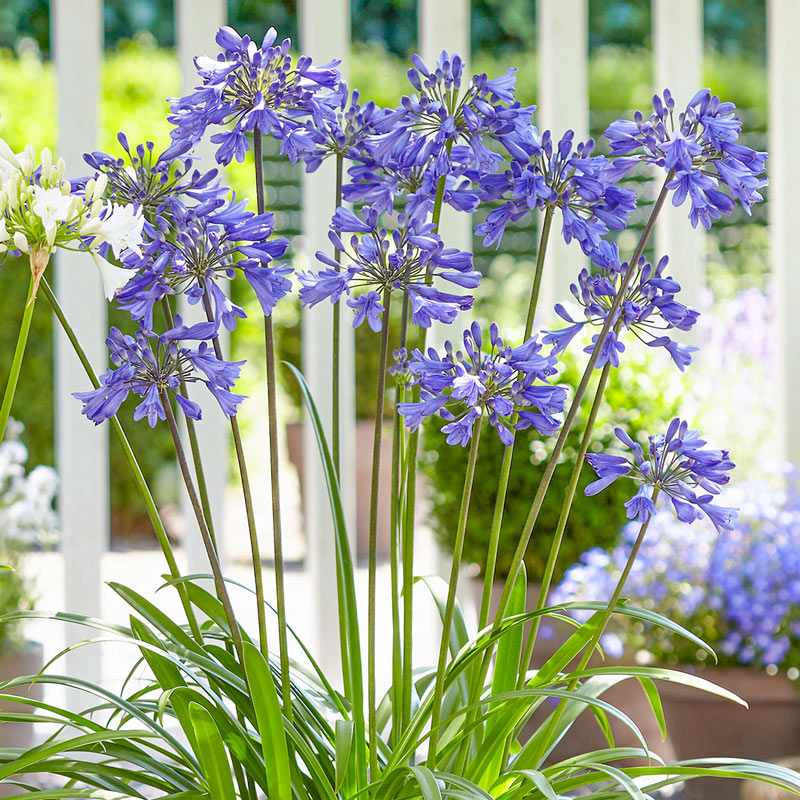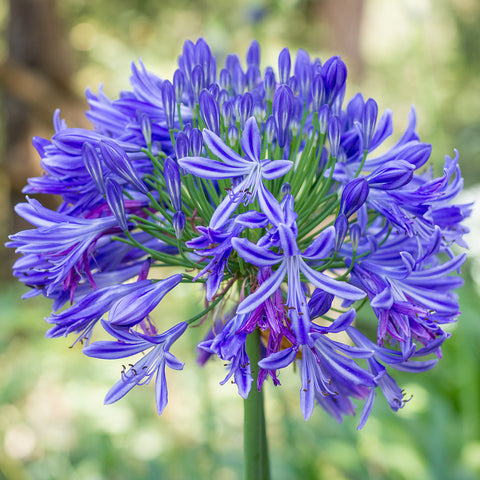Agapanthus Varieties: Selecting the Best for Your Landscape
Agapanthus Varieties: Selecting the Best for Your Landscape
Blog Article
Mastering the Art of Agapanthus Care: Essential Steps for Healthy And Balanced Growth and Dynamic Flowers
In the realm of cultivation, the cultivation of agapanthus stands as a fulfilling venture for those that look for to nurture these elegant flowering plants. From picking the best range to understanding pruning methods, the trip towards growing growing agapanthus plants is complex and holds the crucial to unlocking the full capacity of these botanical treasures.

Picking the Right Agapanthus Selection

When picking the right Agapanthus variety for your yard, consider aspects such as environment viability, blossom shade, and growth routine. Agapanthus, typically called Lily of the Nile or African lily, can be found in a range of shades ranging from shades of purple and blue to white. Choose a bloom color that complements your existing yard scheme to produce an unified landscape. Furthermore, think about the climate in your region to make sure the Agapanthus selection you choose can flourish in your details problems. Some varieties are a lot more tolerant of cool temperature levels, while others like warmer environments. Comprehending the growth habit of various Agapanthus selections is critical for proper positioning within your garden. Some varieties have a clumping growth habit, perfect for borders or containers, while others have an even more dispersing nature, appropriate for ground cover or mass plantings. By very carefully evaluating these factors, you can choose the ideal Agapanthus variety to improve the charm of your garden.
Suitable Growing Problems
Thinking about the optimal ecological requirements is necessary for successful Agapanthus growing. Agapanthus grows in well-draining soil with a somewhat acidic to neutral pH degree. When planting, select an area that receives full sunlight to partial shade. In hotter climates, offering some afternoon color can avoid scorching of the leaves. Agapanthus plants are delicate to chilly temperature levels and need to be secured from frost throughout cold weather.
To make sure healthy growth and dynamic flowers, plant Agapanthus bulbs at a depth of concerning 2-4 inches and room them 8-12 inches apart. Mulching around the base of the plants aids preserve dampness and suppresses weed growth.
Watering and Feeding Tips
Keeping proper wetness degrees and offering essential nutrients are crucial elements in the care routine for Agapanthus plants. When it pertains to sprinkling Agapanthus, it is essential to strike a balance. These plants favor constantly damp dirt but are at risk to root rot if overwatered. Throughout the expanding period, water deeply when a week, making certain the soil is well-draining to stop waterlogging. In hotter climates or during durations of drought, more regular watering may be required to keep the soil evenly wet. Nevertheless, reduce watering in the winter season to stop waterlogged conditions.
Feeding Agapanthus is important for advertising healthy and balanced growth and respected blossoms. Apply a well balanced fertilizer, such as a 10-10-10 formula, in the early spring as brand-new development arises. By complying with these watering and fertilizing suggestions, you can ensure your Agapanthus plants flourish and generate vivid, lasting flowers.
Trimming Techniques for Agapanthus
Trimming Agapanthus plants at the proper times and with appropriate techniques is crucial for maintaining their health and advertising optimal development and flowering. The perfect time to trim Agapanthus is in late winter her comment is here or early spring before brand-new growth arises.
For flowered stems, wait until the blossoms have actually withered and after that trim them back to the base. This not just cleans up the plant's look yet additionally encourages the growth of new flower buds. Deadheading spent flowers can also redirect the plant's energy right into producing more blossoms as opposed to establishing seeds. Nonetheless, if you want to accumulate seeds for proliferation, leave some flowers to mature and dry on the plant.
Remember to use tidy, sharp devices to make exact cuts and minimize the risk of presenting conditions. Agapanthus. Routine pruning will help maintain your Agapanthus looking healthy and neat while ensuring a plentiful screen of gorgeous blooms
Handling Typical Pests and Conditions
After making certain correct pruning methods for Agapanthus, it is crucial to deal with common bugs and illness that can affect the wellness and vitality of these plants. One usual parasite that affects Agapanthus is the Agapanthus gall midge.
An additional common issue is fungal fallen leave place, which offers as dark lesions find more on the leaves. To avoid fungal illness, guarantee good air circulation around the plants, stay clear of overhead watering, and eliminate any type of infected leaves immediately. Additionally, Agapanthus plants can experience from origin rot if they are grown in badly draining dirt. To avoid this, plant Agapanthus in well-draining soil and stay clear of overwatering. By being attentive and taking timely activity versus conditions and insects, you can help your Agapanthus plants prosper and produce vivid flowers.

Conclusion
In final thought, grasping the art of agapanthus treatment includes picking the right variety, giving suitable planting conditions, proper watering and feeding, appropriate trimming methods, and attending to Your Domain Name typical parasites and illness. By following these essential steps, you can make sure healthy growth and vibrant blooms for your agapanthus plants. Keep in mind to on a regular basis monitor and preserve your plants to promote their general wellness and long life.
To guarantee healthy development and dynamic blossoms, plant Agapanthus light bulbs at a deepness of concerning 2-4 inches and room them 8-12 inches apart. By complying with these watering and feeding pointers, you can guarantee your Agapanthus plants grow and generate vivid, long-lasting flowers.
One typical bug that impacts Agapanthus is the Agapanthus gall midge. In addition, Agapanthus plants can endure from root rot if they are planted in improperly draining pipes dirt. By adhering to these vital steps, you can make sure healthy and balanced growth and lively blooms for your agapanthus plants.
Report this page